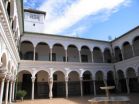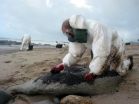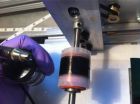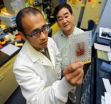(Press-News.org) Researchers from the University of Seville (Spain) have used mathematical tools to assess what has been known for centuries: the temperature inside the typical Mediterranean courtyard is cooler than that of the street. Though seemingly common sense, understanding such information in detail helps to save energy and money, which is the objective of eco-efficient buildings.
The inhabitants of Mediterranean regions have known for centuries that during the summer their courtyards are cooler than the street. "Why then put air conditioning extractor units on rooftops or outer walls when we could save energy by taking the cooler air from inside the courtyard," suggests architect Juan Manuel Rojas.
Along with two lecturers at the University of Seville, the researcher has developed a mathematical tool that for the first time assesses the complex thermodynamic behaviour of the courtyard. Details have been published in the Energies journal.
"These spaces create a mixture of phenomena: stratification (hot air rises and cold air falls); convection (the walls heated throughout the day project air upwards); and flow patterns (whirlwind formation depending on the geometry of the space)," explains Rojas.
All of this information is brought together in a programme using specific data on the local climate (average temperatures and wind speed) and that of the courtyard itself (height, width, the materials with which it was built) since not all absorb the same levels of radiation. The result is a 'film' showing air evolution throughout the day.
"The model allows for the thermal advantages of the courtyards to be assessed. In turn this provides new design possibilities for more efficient and sustainable buildings without going over budget," outlines the architect, who demands that the knowledge and wisdom used for over 4000 years continues in the construction of modern day buildings.
Eco-efficient projects of recent decades tend to do away with courtyards or use glass covered atriums since the greater the surface area, the greater the energy transmission.
"But the energy rating used to calculate this assumes that the air inside and outside of the courtyard is the same temperature. This is not the case and must be considered," insists Rojas, who recognises that closed atriums can work well in Central and Northern Europe.
The researcher's model has been successfully put to the test in a hotel in Malaga (Monte Málaga) following the thermodynamic strategies of the courtyard for an overall improvement in their energy efficiency.
The hotel is air-conditioned by taking the air from the lower part of the courtyard, which can be up to 9 ºC cooler than outside in the summer. This translates as a financial and energy saving, as the building consumes half the energy of the surrounding buildings.
VIDEO:
This shows traditional courtyards: an example of eco-efficiency for architects.
Click here for more information.
New historical vision
The study also offers a new thermodynamic interpretation of historical courtyards ranging from traditional examples in Cadiz and Seville to cloisters of Santiago de Compostela Cathedral and the Palazzo Farnese in Rome.
"The deepest and narrowest courtyards work better in hotter regions, whereas more open ones work better in the North, as we can see by simply searching on Google Maps," says Rojas.
The architect believes that the climate, and not culture or art, has conditioned the most appropriate courtyard type according to region, which has then been continued due to tradition: "In the same way that natural selection chooses the best organisms, the area itself has always determined the use of architectural options that have best exploited available resources."
INFORMATION:
References:
Juan M. Rojas, Carmen Galán-Marín,Enrique D. Fernández-Nieto. "Parametric Study of Thermodynamics in the Mediterranean Courtyard as a Tool for the Design of Eco-Efficient Buildings". Energies 5 (7): 2381-2403, 2012. Doi:10.3390/en5072381.
Traditional courtyards: an example of eco-efficiency for architects
2012-10-15
ELSE PRESS RELEASES FROM THIS DATE:
Exposure to 'Prestige' fuel causes short-term damage to rat DNA
2012-10-15
An experiment carried out on rodents exposed to fuel similar to that of the Prestige tanker oil spill – which took place nearly a decade ago – shows that inhalation of the fuel causes damage to genetic material. According to the study, led by the University of A Coruña, the results could be used in relation to people who carry out the industrial cleaning of coasts.
On 19 November, it will be ten years since the sinking of the Prestige, which caused one of Spain's largest ecological disasters. The oil spill reached the coasts of Galicia and the rest of the Cantabrian coast, ...
Replicating risk genes in bipolar disorder
2012-10-15
Philadelphia, PA, October 15, 2012 – One of the biggest challenges in psychiatric genetics has been to replicate findings across large studies.
Scientists at King's College London, Institute of Psychiatry have now performed one of the largest ever genetic replication studies of bipolar affective disorder, with 28,000 subjects recruited from 36 different research centers. Their findings provide compelling evidence that the chromosome 3p21.1 locus contains a common genetic risk for bipolar disorder, the PBRM1 gene.
The locus at 3p21.1 has also been previously associated ...
Soccer scores a health hat trick for hypertensive men
2012-10-15
Playing soccer (football) could be the best way for people with high blood pressure, known as hypertension, to improve their fitness, normalise their blood pressure and reduce their risk of stroke. Research from Universities of Exeter and Copenhagen, and Gentofte University Hospital in Denmark, published today (Monday 15 October 2012) in the journal Medicine and Science in Sports and Exercise, suggests that soccer training prevents cardiovascular disease in middle-aged men with hypertension and is more effective than healthy lifestyle advice currently prescribed by GPs.
After ...
Programs for treating addiction in doctors pose ethical issues
2012-10-15
Philadelphia, Pa. (October 15, 2012) – State physician health programs (PHPs) play a key role in helping doctors with substance abuse problems. But the current PHP system is inconsistent and prone to potential conflicts of interest and ethical issues, according to a review available as publish ahead of print content from the December 2012 issue of Journal of Addiction Medicine, the official journal of the American Society of Addiction Medicine. The journal is published by Lippincott Williams & Wilkins, a part ofWolters Kluwer Health.
In the article, Drs J. Wesley Boyd ...
'Treasure trove' of film records unlocks history of British Cinema
2012-10-15
A film historian at Queen Mary, University of London has been uncovering the secret past of British cinema in a private collection of production records for thousands of films, including such iconic titles as Dr No, The African Queen, and Zulu.
The unique production archive is owned by Film Finances Ltd, underwriters of many major British films made since the 1950s. The company has kept complete documentation for
every production it has guaranteed, including letters, telegrams, shooting schedules, scripts, storyboards and even doctors' certificates.
In 2009, Film Finances ...
New techniques stretch carbon nanotubes, make stronger composites
2012-10-15
Researchers from North Carolina State University have developed new techniques for stretching carbon nanotubes (CNT) and using them to create carbon composites that can be used as stronger, lighter materials in everything from airplanes to bicycles.
By stretching the CNT material before incorporating it into a composite for use in finished products, the researchers straighten the CNTs in the material, which significantly improves its tensile strength – and enhances the stiffness of the composite material and its electrical and thermal conductivity.
State-of-the-art ...
Aggregation of proteins in cells may result in diseases
2012-10-15
Many diseases are caused by proteins losing their natural three-dimensional structure and thus their function. In most cases, the damaged proteins are degraded by different systems in the cells, but in some cases, the proteins begin to aggregate and form very well-organised rope-like structures called fibrils. These structures have now been linked to many different diseases, such as Alzheimer's, Parkinson's, type 2 diabetes and corneal dystrophies (opaqueness in the cornea).
It has long been known that corneal dystrophy is caused by a mutation of a protein called TGFBIp ...
The Romans used Greek myths in their mosaics as symbols of civilization
2012-10-15
This press release is available in Spanish.This line of research, coordinated by Luz Neira, who is a professor in the Department of Humanities: History, Geography and Art, as well as a researcher in UC3M's Institute for Culture and Technology (Instituto de Cultura y Tecnología), continues on the path established by previous studies that examined the images of women and certain legends in Roman mosaics. "We had previously shown the memory and conscious, self-interested reuse of myths, but this new volume also examines the possibility that there is a subliminal message regarding ...
Protein could be key for drugs that promote bone growth
2012-10-15
AUGUSTA, Ga. – Georgia Health Sciences University researchers have developed a mouse that errs on the side of making bone rather than fat, which could eventually lead to better drugs to treat inflammatory diseases such as rheumatoid arthritis.
Drugs commonly used to treat those types of conditions – called glucocorticoids – work by turning down the body's anti-inflammatory response, but simultaneously turn on other pathways that lead to bone loss. The result can lead to osteoporosis and an accumulation of marrow fat, says Dr. Xingming Shi, bone biologist at the GHSU ...
Antibiotic contamination a threat to humans and the environment
2012-10-15
Researchers from the University of Gothenburg, Sweden, spend August in Sisimiut on the west coast of Greenland studying the prevalence of antibiotic resistance and the effects of antibiotic emissions on communities of bacteria living in marine sediments. More specifically, they were investigating how communities of bacteria in sediment and clay on the seabed are affected by exposure to antibiotics.
"We know very little about what happens to antibiotics that end up in the ocean, but several substances can accumulate in sediments where biodegradation occurs extremely slowly," ...




